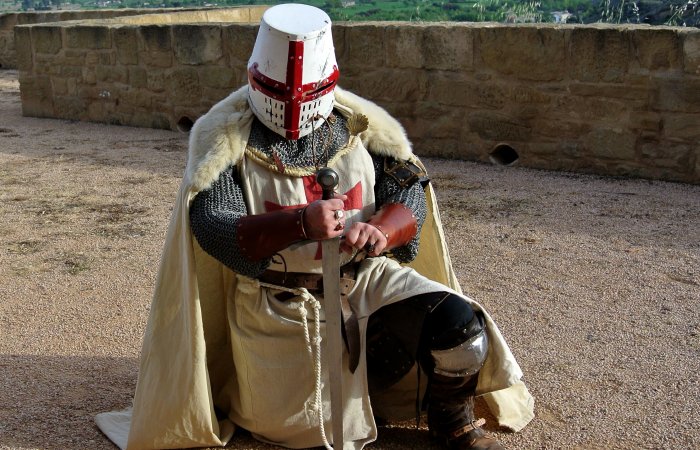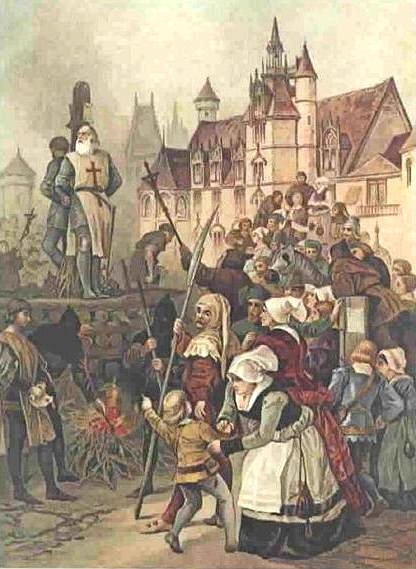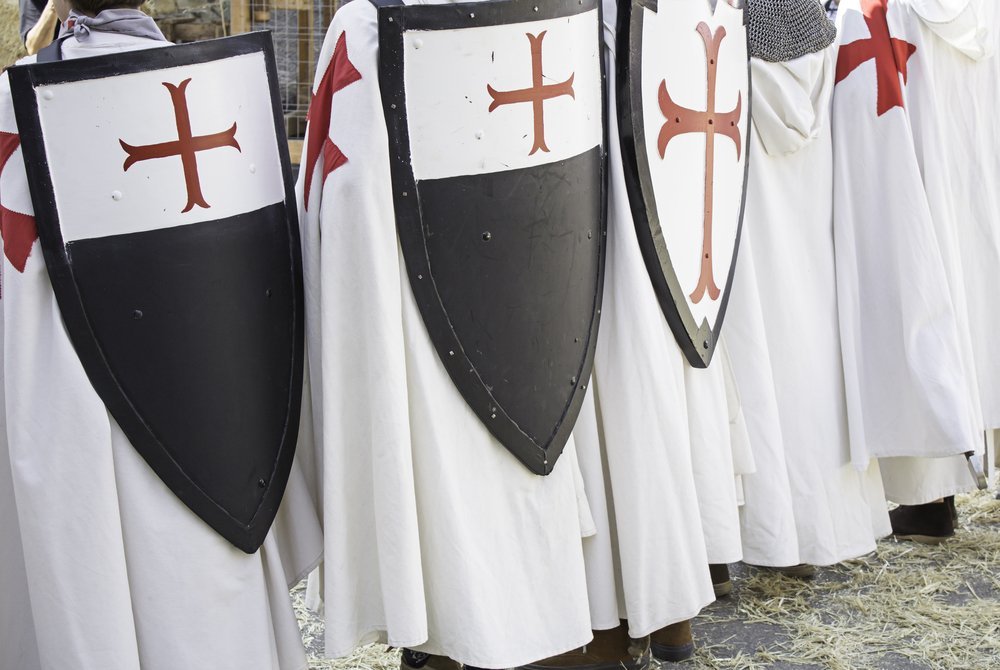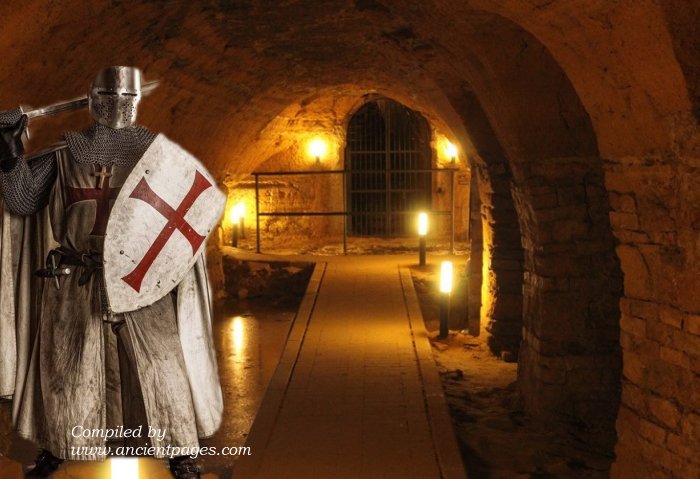Ellen Lloyd – AncientPages.com – There are many historical books and movies about the Knights Templar, and yet, mystery surrounds almost every aspect of their story.
In just 200 years, the Knights Templar successfully created the most important Christian organization in the world. Admired and feared, the knights fought in the name of the Christian Cross, eliminating infidels and heretics.

The Knights Templar were accused of horrible acts, but were they guilty? Credit: Maria – Adobe Stock
“Already in the times of the existence of the Knights Templar Order, there were numerous legends of proud knights clad in white, who either spent every day hid behind the walls of their strongholds or fought in battles but never feared death.” 1
Some of these legends are still alive, but distinguishing rumors from historical facts has been challenging.
Wealthy Knights Templar Became A Threat To Kings And The Pope
Their success on the battlefield in the Holy Land earned them fame and glory. The Knights Templar became extraordinarily rich but being wealthy often attracts jealousy and resentment.
As their power and wealth grew, many kings and even the Pope were in debt. It was difficult to cancel the debt, and the Knights Templar became a problem.
At the beginning of the 14th century, the Knights Templar were accused of horrifying crimes, leading to their abrupt and dramatic suppression.
Many historians have tried to figure out whether the knights were really guilty of these crimes or simply framed by King Philip IV of France and Pope Clement V. In 1306, Philip expelled the Jews from France, and in 1307 he annihilated the order of the Knights Templar.
On November 22, 1307, a Papal Bull, the so-called “Pastoralis Praeeminentiae” was issued by Pope Clement V to all Christian monarchs.
Monarchs of Christendom were given orders to arrest the Knights Templar and sequester their lands in the name of the papacy.
Pope Clement supported the campaign against the Templars by Philip IV of France, who owed them a great deal of money and had initiated the first arrests against the Templars on 13 October 1307.
The Knights Templar were arrested, charged with heresy and and thrown in prison.
Even the Grand Master of the order, the famed Jacques de Molay, was arrested in Paris with 60 of his knights that day.
After days of torture, Jacques de Molay confessed that some charges against the order were true.
“However, he rejected a charge of sodomy.
He wrote to Templars throughout France, enjoining confession. Still, when the pope sent his own delegates to conduct the inquiries, Molay and many of his subjects retracted their statements, saying they had been exacted by torture.

Jacques de Molay, the last grandmaster of the Knights Templars was burned at the stake. Credit: Public Domain
In November 1309 and in March 1310, Molay appealed for a personal judgment by the pope. But Clement decided to suppress the order (March 1312); and on March 18 or 19, 1314, a commission of three cardinals condemned Molay and other dignitaries of the order to perpetual imprisonment.
On hearing this sentence, Molay again retracted his confession, and as a final punishment, he was burned as a relapsed heretic by Philip IV’s officers the same afternoon.” 2
Legend has it that Molay cursed the French King shortly before he died, but there is no historical evidence this happened. An eyewitness to the execution stated that Molay had shown no sign of fear and had told those present that God would avenge their deaths.
The main question of interest is whether the Knights Templar were guilty or not. Historians still discuss this subject, and opinions about what happened are diverse.
Let us start by examining what the Knights Templar were accused of and what speaks for and against these charges.
What Were The Knights Templar Accused Of?
Considering the Knights Templar were Christian warrior monks who engaged in a Holy war, it’s understandable the charges against the Order would quickly “damn them in the eyes of the populace and opening them up to the ‘guilty until proven innocent’ process of the Inquisition. By bringing accusations of heresy, devil-worship, and Sєxual depravity against the Templars,” Philip IV” hoped to isolate them: few would come to their defense for fear of being tainted themselves.”3
The Knights Templar were accused of spitting on the cross, and there is some evidence this accusation had a basis in fact. For one thing, some Knights Templar did confess they had participated in this practice. Also, a couple of the French King’s spies who joined the Order secretly stated they witnessed this happen, and the discovery of the Chinon Parchments in the Vatican library confirms the charges. Then we mustn’t forget that Jacques de Molay admitted to such practices while being questioned.

Some of the Knights Templar confessed while being submitted to torture. Credit: Stock PH๏τo
What speaks in favor of the Knights Templar and against this accusation is that the Knights Templar and Jacques de Molay confessed while being tortured. It’s also possible the King’s spies did see some ritual being performed, but they misunderstood its purpose.
The next serious accusation against the Christian warrior monk was worshiping an idol called Baphomet. The charge against the Knights Templar read: they surrounded or touched each head of the idols with small cords, which they wore around themselves next to the shirt or the flesh.”
This charge was different from the spitting-on-the-cross accusation because, at this time, King Philip IV didn’t have any inside information that could strengthen his case. When the charges were presented, many knights did agree they worshipped this idol, “which usually took the form of a life-sized head. We know for a fact that the Knights Templar possessed heads, such as the head of St. Eupheima of Chalcedon. The fact that the Order kept these heads means that they certainly could have worshipped them in some way.“ 4
What speaks against this accusation and in favor of the Order is that only nine knights admitted worshipping the idol, and once again, the confessions were made under torture. It’s also possible the idol named Baphomet was a mistranslation of Mahomet. Also, “if the Templars did indeed worship such an idol, it seems unusual that their temples were not filled with clear symbols of this figure.” 4

Did the Knights Templar meet in secret places and engage in heretic rituals? Credit: AncientPages.com
The third serious accusation was the knights were homoSєxual. “The charges the Templar faced were that “they told the brothers whom they received they could have carnal relations together… that they ought to do and submit to this mutually.” As the Templars took vows of celibacy and were not permitted to wed, they were believed to engage in homoSєxual activity to satisfy their desires. Although few confessed, many testified that Sєxual activity was not prohibited. The fact that so many denied it under torture indicates how shameful sodomy was viewed, giving the Templars all the more reason to hide the truth.
What speaks in favor of the knights is that this “ was the most common accusation used during this era to discredit or ruin anyone. Philip had already charged Pope Bonificae VIII with similar accusations, and it seemed to be his favorite tool to use against his enemies as it was difficult to disprove. However, despite the torture, only three Templars confessed to sodomy in the Paris trials. Although de Molay was quick denying Christ, he vehemently opposed this accusation, stating that the Templar rules clearly prohibit any such behavior with harsh punishment, such as expulsion from the Order.” 4
So as we have just seen, some facts do speak against the Knights Templar, but the circumstances under which confessions were made are questionable. Most would confess almost anything under torture.
What is interesting is that King Philip IV, suffering a financial crisis, “did not even ask for the Templars’ possessions or land. In a letter to Pope Clement V at the Council of Vienne in March 1312, in which he pressed Clement to abolish the Templars, Philip recommended that he should either create a new Order to replace them, which would inherit the Templars’ property and lands or that these be transferred to one of the other orders.” 3
This gives us much to ponder, and most historians agree on the case for and against the accusations Knight Templar faced remains open.
Written by Ellen Lloyd – AncientPages.com
Updated on August 31, 2022
Copyright © AncientPages.com All rights reserved. This material may not be published, broadcast, rewritten or redistributed in whole or part without the express written permission of AncientPages.com
Expand for references
- Sutherland – Knights Templar – Among The Most Wealthy And Powerful Of The Western Christian Military Orders – AncientPages.com
- com – On This Day In History: Knights Templars’ Jacques de Molay Burned At The Stake – On Mar 18, 1314
- com – The Knights Templar
- All About History – History Of The Occult, 2018, Future Publishing Limited





